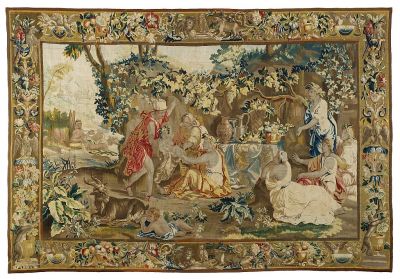
Tapestry - Merury hands over the infant Bacchus to the nymphs
| Accession Nr.: | 24376 |
|---|---|
| Artist/Maker: |
Schoor, van, Lodewijk (1666 - 1726) / glass-engraver Borcht, van der, Jacob (1676 - 1710) / glass-engraver |
| Date of production: |
late 17th - early 18th century
|
| Place of production: | Brussels |
The tapestry used to be part of a series of mythological scenes containing eight pieces. The most famous and - in the baroque period - the most favourite literary adaptation of the story of Semele is to be read in Ovid's Metamorphoses (III. 287-315). The mother of Bacchus entreated Jove (Jupiter) to appear to her. He fulfilled her wish and she was burnt in the celestial light surrounding the God. Jove had torn the child out the womb of his mother and until his birth he put him in his thigh. Later the child was sent with Jove's envoy, Mercury to the Nymphs living in the Nysa region to bring him up. In the middle of the tapestry Mercury is handing over the child on the right is the group of Nymphs, on the left Silenus enjoys the cool of the stream. The cave of the Nymphs is in the back-ground, and is covered with scrolls and foliage and ripe bunches of grapes, before it stands a table groaning with fruit and jugs. On the trimmings are garlands, fruit dishes, birds, monkeys above and below in the middle an owl is flanked by a lion and a dog. In the last quarter of the 17th century tapestry weaving in Brussels was greatly influenced by the Gobelin Manufacture of Paris. This French influence manifests itself in the love of mythological and allegorical themes, in figures shown in antique costumes, in the landscapes typical of Poussin and Lorrain, and in the use of brighter colours. One of the most creative cartoonists of this style was Louis van Schoor (+1702), the designer of these series of tapestries. He used as models the engravings of Jean Dughet and Jean Versini, which had been made after the painting of Nicolas Poussin — The Birth of Bacchus, 1657. The trimmings are new, so there is no mark. On the basis of its mark - I.V.D.B. - the complete series in Vienna was woven in the Brussels workshop of Jacob van der'Borght (1676-1710) about 1700. Similar tapestries: Poznan, Muzeum Narodowe.
Literature
- Szerk.: András Edit: Ovidius Átváltozások című műve alapján készült 16-17. századi kárpitok a budapesti Iparművészeti Múzeum gyűjteményéből. Kárpit 2. Átváltozások. A szövött kárpit művészete egykor és ma. Szépművészeti Múzeum, Budapest, 2005. - 24-32. (László Emőke)
- Szerk.: Szilágyi András, Péter Márta: Barokk és rokokó. Az európai iparművészet stíluskorszakai. Iparművészeti Múzeum, Budapest, 1990. - Nr. 3.1. (László Emőke)
- fényképész: László Emőke, Wagner Richárd: Képes kárpitok az Iparművészeti Múzeum gyűjteményében. I. 17-18. századi kárpitok. Iparművészeti Múzeum, Budapest, 1987. - Nr. 10.
- Szerk.: Voit Pál, László Emőke: Régiségek könyve. Gondolat Kiadó, Budapest, 1983. - p. 384., 16. kép
- László Emőke: Flamand és francia kárpitok Magyarországon. Corvina Kiadó, Budapest, 1980. - Nr. 53.
- Szerk.: Miklós Pál: Az Iparművészeti Múzeum gyűjteményei. Magyar Helikon, Budapest, 1979. - p. 298.
- főszerkesztő: Weiner Mihályné, Jakabffy Imre: Egy Bacchus jelenetes kárpitról. Az Iparművészeti Múzeum Évkönyvei VII, 1964. Képzőművészeti Alap Kiadóvállalata, Budapest, 1964. - 23-33. (Egyed Edit)

